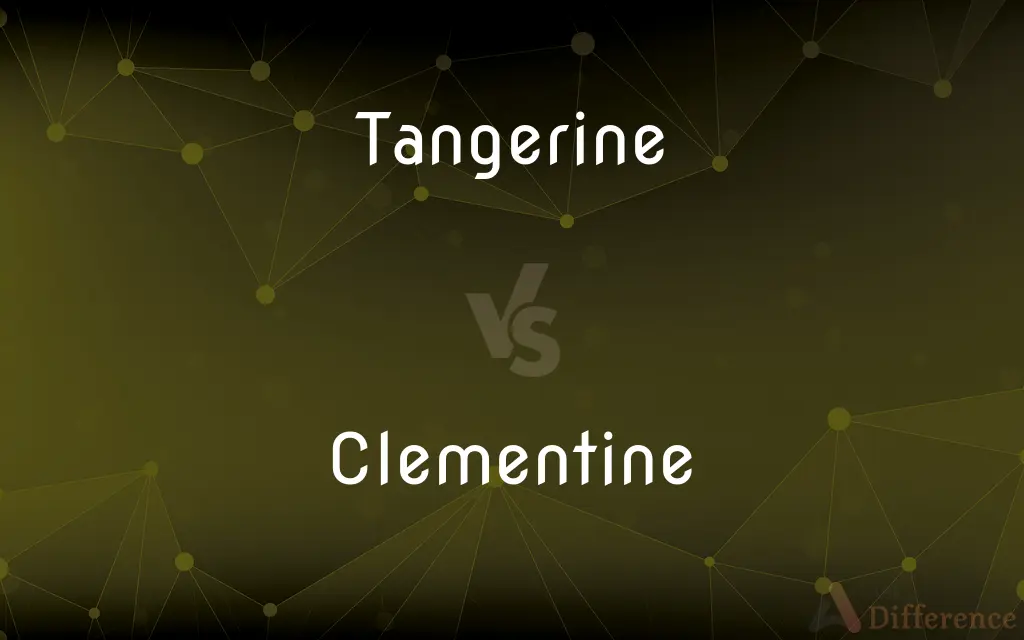Tangerine vs. Clementine — What's the Difference?
Edited by Tayyaba Rehman — By Fiza Rafique — Updated on March 14, 2024
Tangerines are larger with a thicker, pebbly skin, and a sweet-tart flavor, while clementines are smaller, seedless, with a smoother, thin skin and a sweeter taste.

Difference Between Tangerine and Clementine
Table of Contents
ADVERTISEMENT
Key Differences
Tangerines, a type of mandarin orange, are known for their bold, sweet-tart flavor which is ideal for both eating fresh and culinary uses. On the other hand, clementines are a sweeter variety of mandarin, often preferred for fresh eating due to their seedless nature and easy-to-peel skin.
The skin of a tangerine is thicker, with a pebbly texture that can vary in color from deep orange to red-orange. In contrast, clementines have a notably thin, smooth skin that is easier to peel, making them a popular choice for snacks, especially for children.
Tangerines are generally larger than clementines and can have a few seeds, which might require removal when eating or using in recipes. Clementines, being smaller and seedless, offer a convenient, no-fuss eating experience.
The seasonality of these fruits also differs slightly; tangerines are typically in season from late fall through winter, whereas clementines are most abundant in the late fall to early winter, making them a common treat during the holiday season.
In terms of nutritional content, both tangerines and clementines are excellent sources of vitamin C, fiber, and antioxidants, though the exact levels can vary slightly due to their differences in size and variety.
ADVERTISEMENT
Comparison Chart
Size
Larger
Smaller
Skin Texture
Thicker, pebbly
Thin, smooth
Flavor
Sweet-tart
Sweeter
Seeds
May contain seeds
Seedless
Seasonality
Late fall through winter
Late fall to early winter
Peelability
Easier than oranges but tougher than clementines
Very easy to peel
Compare with Definitions
Tangerine
Tangerines have a vibrant sweet-tart taste that enhances both fresh and culinary applications.
The sweet-tart flavor of the tangerine added a zesty twist to the salad.
Clementine
Clementines are known for their sweet flavor, making them a favorite, especially among children.
The sweet clementine was a perfect, refreshing snack for the kids.
Tangerine
The skin of a tangerine is thicker and textured, contributing to its distinctive appearance.
She appreciated the pebbly texture of the tangerine's skin as she peeled it.
Clementine
The skin of a clementine is remarkably smooth and thin, allowing for effortless peeling.
She effortlessly peeled the smooth, thin skin of the clementine in one go.
Tangerine
Tangerines are generally larger than their clementine counterparts, offering more fruit per piece.
The large tangerine filled his palm, promising a juicy treat.
Clementine
Clementines are smaller than tangerines, making them an ideal quick and easy snack.
The small clementine fit perfectly in his lunchbox as a sweet treat.
Tangerine
Some tangerines contain seeds, requiring removal when eaten or used in recipes.
As she sectioned the tangerine, she carefully removed the few seeds it contained.
Clementine
The absence of seeds in clementines offers a convenient eating experience without the hassle of deseeding.
She enjoyed the clementine even more, knowing there were no seeds to contend with.
Tangerine
Tangerines are in season from late fall to winter, making them a popular winter fruit.
The arrival of tangerines at the market signaled the start of the winter season.
Clementine
Clementines are most abundant in the late fall to early winter, often associated with holiday feasting.
The bowl of clementines on the table became a staple during their holiday gatherings.
Tangerine
The tangerine is a type of orange. Its scientific name varies.
Clementine
A clementine (Citrus × clementina) is a tangor, a citrus fruit hybrid between a willowleaf mandarin orange (C. × deliciosa) and a sweet orange (C. × sinensis), named for its late 19th-century discoverer. The exterior is a deep orange colour with a smooth, glossy appearance.
Tangerine
A widely cultivated variety of mandarin orange having deep red-orange fruit with easily separated segments.
Clementine
A deep red-orange, often seedless mandarin orange.
Tangerine
A strong reddish orange to strong or vivid orange.
Clementine
A type of small, sweet orange, the result of a cross between a tangerine and Seville orange.
Tangerine
Any of several varieties of mandarin oranges.
Clementine
Of or pertaining to Clement, esp. to St. Clement of Rome and the spurious homilies attributed to him, or to Pope Clement V. and his compilations of canon law.
Tangerine
A deep yellowish-orange colour, like that of a tangerine fruit.
Clementine
A variety of mandarin orange that is grown around the Mediterranean and in South Africa
Tangerine
A tree that produces tangerines.
Mandarin orange
Clementine
A mandarin orange of a deep reddish orange color and few seeds
Tangerine
Of a deep yellowish-orange colour.
Tangerine
A kind of orange, much like the mandarin, but of deeper color and higher flavor. It is said to have been produced in America from the mandarin.
Tangerine
A variety of mandarin orange
Tangerine
Any of various deep orange mandarins grown in the United States and southern Africa
Tangerine
A reddish to vivid orange color
Tangerine
Of a strong reddish orange color
Common Curiosities
Are tangerines and clementines good sources of vitamin C?
Both are excellent sources of vitamin C, along with fiber and antioxidants.
Which is better for snacking, a tangerine or a clementine?
Clementines are often preferred for snacking due to their sweet taste, seedless nature, and easy-to-peel skin.
What is the main difference between a tangerine and a clementine?
The main difference is in size, peelability, and taste; tangerines are larger, slightly harder to peel, and have a sweet-tart flavor, while clementines are smaller, seedless, easier to peel, and sweeter.
Can tangerines and clementines be used interchangeably in recipes?
Yes, they can often be used interchangeably, but the seed presence in tangerines and the sweeter taste of clementines should be considered.
Are tangerines or clementines more acidic?
Tangerines might be slightly more acidic due to their sweet-tart flavor profile.
Why are clementines associated with the holiday season?
Clementines are most abundant in the late fall to early winter, making them a popular treat during the holiday season.
Do tangerines have more calories than clementines?
The calorie content is similar, but it may vary slightly due to the size difference, with larger tangerines potentially having more calories.
How should tangerines and clementines be stored?
Both should be stored in a cool, dry place, and they can be refrigerated to extend their freshness.
Which is easier to peel, a tangerine or a clementine?
Clementines are known for their very easy-to-peel skin, making them easier to peel than tangerines.
Do tangerines or clementines have more sugar?
Clementines may have slightly more sugar due to their sweeter taste, but the difference is minimal.
Can you grow tangerines and clementines in the same climate?
Yes, both can grow in similar warm climates, but specific conditions can affect their quality and growth.
Are there seedless varieties of tangerines?
While less common, there are some seedless varieties of tangerines available.
Can you freeze tangerines and clementines?
Yes, both can be frozen, but they are best consumed fresh for the best taste and texture.
Can tangerines and clementines help with weight loss?
Both are low in calories and high in fiber, making them a healthy snack option that can aid in weight management.
Which is more popular worldwide, tangerines or clementines?
Clementines are popular worldwide, especially in regions where easy-to-eat, seedless fruits are preferred.
Share Your Discovery

Previous Comparison
Province vs. Municipality
Next Comparison
Renin vs. RenninAuthor Spotlight
Written by
Fiza RafiqueFiza Rafique is a skilled content writer at AskDifference.com, where she meticulously refines and enhances written pieces. Drawing from her vast editorial expertise, Fiza ensures clarity, accuracy, and precision in every article. Passionate about language, she continually seeks to elevate the quality of content for readers worldwide.
Edited by
Tayyaba RehmanTayyaba Rehman is a distinguished writer, currently serving as a primary contributor to askdifference.com. As a researcher in semantics and etymology, Tayyaba's passion for the complexity of languages and their distinctions has found a perfect home on the platform. Tayyaba delves into the intricacies of language, distinguishing between commonly confused words and phrases, thereby providing clarity for readers worldwide.
















































